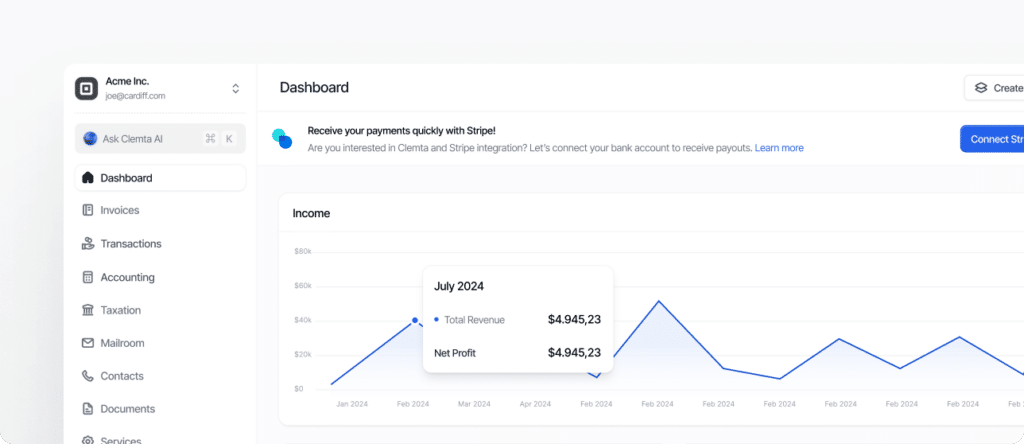Starting an online business is an exciting idea and has the potential to bring impressive revenue with relatively little effort. This journey brings many questions and selections along the way – the first is which platform to choose in order to launch the business. Having a Shopify store is one of your options.
Shopify is one of the most well-known and trustworthy e-commerce platforms, and quite a few online businesses that are known to be successful -some are still operating with Shopify.
Through Shopify, you can start an online store with an international customer base and increase your revenue successfully at a fast pace. This process requires company formation in the United States for those in other countries. Starting your business in the US can be intricately exhausting. However, we are ready to offer our support and services to help you start your US-based business seamlessly.
What is Shopify, and What Does It Offer?
Shopify is one of the most favored e-commerce platforms worldwide, with more than two million active users. There is no surprise since the platform is adorned with spectacular tools to help you launch and execute your business as smoothly as possible. What’s more, you don’t need any kind of coding skills or tech knowledge to run your store.
Shopify completely removes the limitations caused by location – you can find customers or clients from anywhere around the world. As its name has become synonymous with trustworthiness, the purchase process leaves no questions in the minds of buyers.
With Shopify’s practical tools, you can make your online store a full-time income business or a part-time business with your other projects until you feel ready. It’s entirely up to you to decide how much time you want to spend on your store.
1. Find Your Angle
You want to open an online store on Shopify, but don’t know what to sell? It’s okay – most people choose their product, competitive angle, or idea after they decide to start an online store. More than 1.75 million businesses use Shopify worldwide in 2022, and you may expect a large chunk of them to be your competitors when you start selling.
To make your online store visible and preferable to potential customers, some issues should be considered thoroughly before taking action. If you are in a position to procure a rare product to sell, that’s great! But if you don’t, you have two choices. Either your price or your marketing and branding efforts can be your selling point.
You can sell your products cheaper than competitors to attract more customers while maintaining a healthy profit. Or, you can spend time and money on marketing and building a unique brand identity, which can generate high revenue even if your product is nothing special.
No matter what your angle is, always be realistic and don’t have too high expectations at the beginning. To gain insights, research the competition channels regularly and write a business plan to see every detail.
2. Form Your Target Audience for Shopify Store
A target audience is quite similar (not entirely the same) to end users who will buy your product. Sometimes, the target audience may consist of larger communities than end users when the end user is a child or when it is a B2B operation.
To shape your target audience, find out about your potential customers as much as you can. Surveys are your best bet, but you can also use reliable research resources like Gartner to gain insights into the customers and the market.
Another research that you should conduct is on your competitors. Find out who their customers are and use their demographic information to build buyer personas. The buyer personas will also help you create successful marketing campaigns in the future with robust, personalized messages.
3. Choose a Business Model and Set Your Prices
Business models depend on how you procure the products or services and the type of your buyers. If you target businesses, your business model is B2B, and if your target audience consists of individuals, it’s called a B2C business model.
Dropshipping has been very popular in the last few years and promises success as long as you seek support from the right places. Wholesales is also a good business model if you have the necessary resources. For those good at branding and social media, a subscription-based business model may also be a great idea. They all have their disadvantages as well as perks.
Don’t forget to consider your skills while determining your business model. Wholesale business requires a lot of collaboration with manufacturers and logistics professionals – you have to rely on your interpersonal skills to be successful (or have the budget to hire someone to do these for you!). Your skills can make or wreck your business.
Setting your prices on this step is also a good idea. Be realistic, and don’t overestimate your abilities or your product’s upcoming popularity. But also, make sure you are making a profit since that’s the main point of starting an online store.
4. Create Your Online Shopify Store
Since the decision process is over, you can finally create your store. Shopify offers different plans according to your needs and budget. You can always start from small and choose the more advanced plans as your business grows.
Make sure to create all essential pages before launching your brand and store. These include about, contact, FAQ pages, and information about the purchasing process and your products.
5. Manage Your Inventory
If you sell a high number of items, it is always a good idea to have a tool to keep track of your inventory and stocks. That way, you will never run out of products and leave your customers disappointed and angry. These drawbacks may result in negative reviews, which can significantly affect your brand.
6. Set Up the Payment Method
The next step, naturally, is to set up the payment method. Unfortunately, some countries face governmental restrictions when it comes to receiving payment.
To easily access payment systems such as Stripe and Paypal, you must have a business in the United States and a bank account associated with it.
With Clemta, you can set up your business in the United States, get the company registration, EIN, and ITIN numbers requested when registering an e-commerce platform and accessing payment systems, and open a bank account.
7. Choose the Shipping Method
Most customers prefer free shipping. Even increasing your product’s price in order to drop your shipping fees is a perfectly acceptable strategy in e-commerce. Environmentally conscious customers also want green and carbon-neutral choices when it comes to shipping. You can opt for these depending on the buyer personas you created and your preferences.
– Domestic vs. International
When selecting the shipping company for domestic orders, compare prices and reviews and choose the best one for you. International shipping is more complex, though. Too many problems are bound to arise if you do not know the customs and orders of the countries you ship to.
Do thorough research, learn as much as possible about laws, prohibited products, international shipping companies, and their reviews, and make your decisions later. And if you are not happy with them, you can always change your mind and try out other companies.
8. Set Your Marketing Strategy & Execute Your Campaigns for Shopify Store
Even this is the last step in our article; you should start building your strategy and promoting your brand as soon as the idea pop-ups in your mind. This will help you gain new leads, potential customers or clients, and even investors.
If you are starting small, you can always learn about digital marketing and social media on your own and hire help and invest in paid marketing tools as your business grows. And a good marketing plan can increase your revenue and brand loyalty of your customers.
There’s no need to put your entrepreneurial dreams on hold. Thanks to Clemta, you can start your business in the US and begin selling products on your Shopify online store smoothly. Contact us now and start selling!







